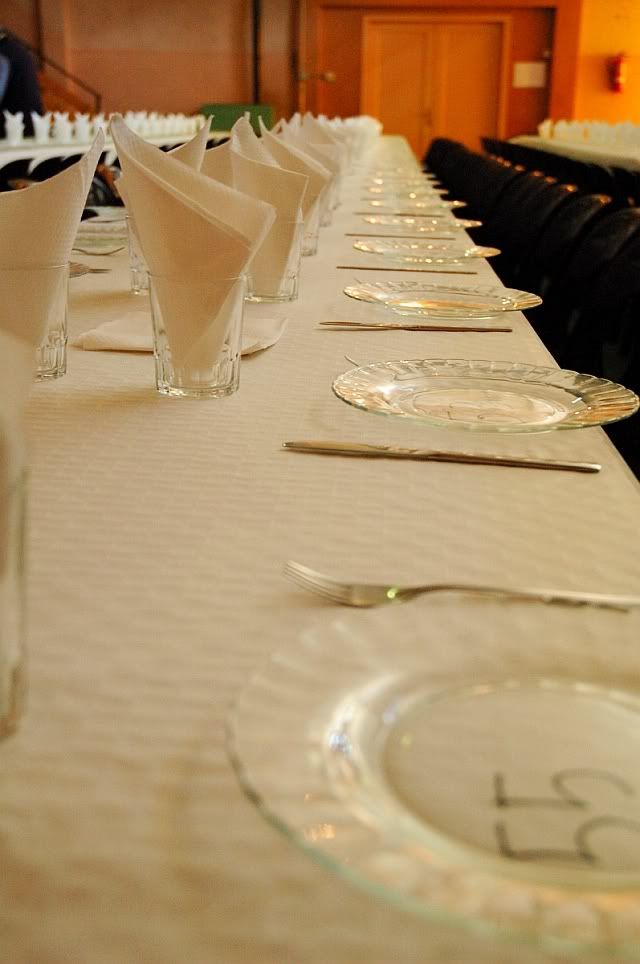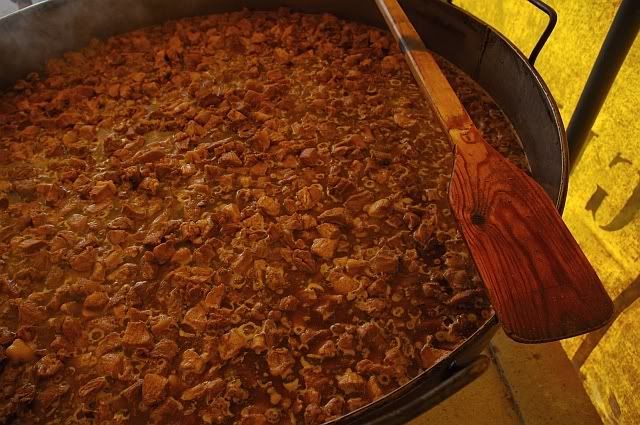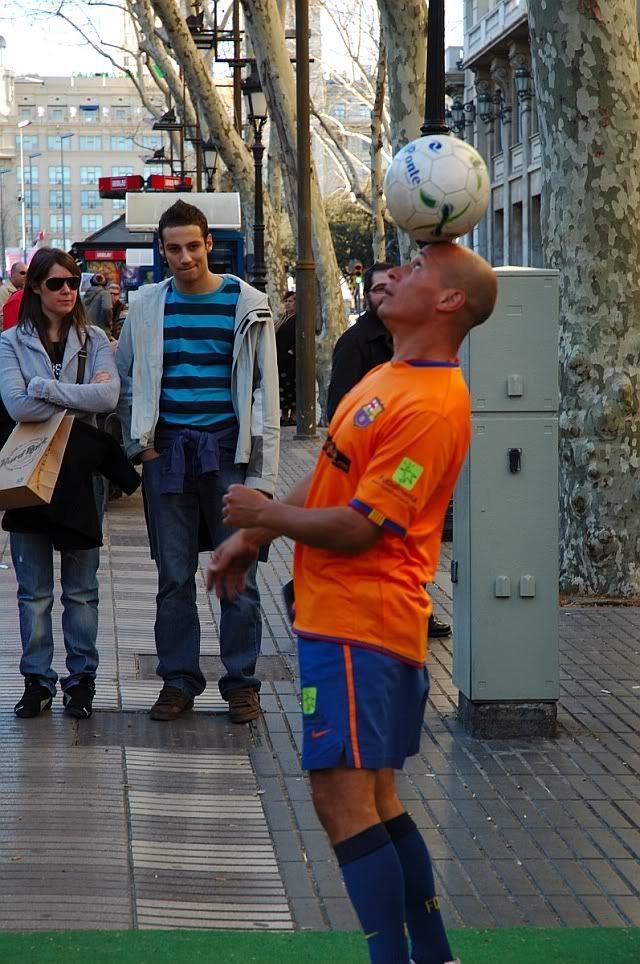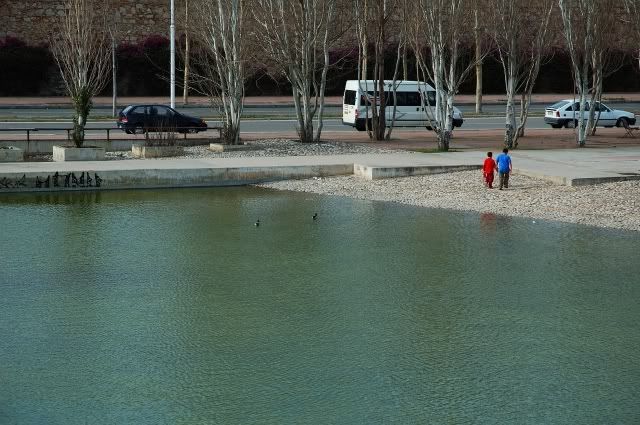Sobrasada (Sausage Spread) is in the group of sausages made with pork. It is prepared with minced meat and lard. The great amount of Spanish paprika or "pimentón" gives it the characteristic color and the peculiar flavor. Sobrasada is a Majorcan speciality. Although you can buy it all over Spain, the authentic, the one that really makes a difference, is from Majorca in the Balearic Islands.
Barcelona photos: Daily photographs of Barcelona, Spain. Pictures of a modern city with travel tips in a personal photoblog. A photography and travel site. Art, architecture, people and traditions. Travel to Barcelona through my camera, know more about our city and towns nearby. Welcome!
Wanna be featured?
June 19, 2008
Sausage Spread or Sobrasada
Sobrasada (Sausage Spread) is in the group of sausages made with pork. It is prepared with minced meat and lard. The great amount of Spanish paprika or "pimentón" gives it the characteristic color and the peculiar flavor. Sobrasada is a Majorcan speciality. Although you can buy it all over Spain, the authentic, the one that really makes a difference, is from Majorca in the Balearic Islands.
June 18, 2008
Spanish Food: Aged Manchego Cheese
![Spanish Food: Aged Manchego Cheese [enlarge]](https://i63.photobucket.com/albums/h135/carloslorenzo/AgedManchegoCheese_.jpg)
Named after La Mancha which is the Spanish region of famous Don Quixote, these aged Manchego cheese are made of sheep milk. They say the aroma reminds of lanolin and roast lamb. It has a slightly briny, nutty flavor and at the age of 13 weeks it is considered cured (curado). Over that period it is referred to as aged (viejo). There are other well known kinds of Spanish cheese: Cabrales, Idiazabal, Zamorano, Tetilla, Liebana, Roncal...In Catalonia we have Mató de Montserrat which is a fresh cheese (formatge fresc). From the Balearic Islands, specifically from Menorca, we have Mahon cheese which is one of my favorites. A link today: The Encyclopedia of Cheese.
June 17, 2008
June 16, 2008
Pan de Payés or Pa de Pagès: Traditional Peasant's Bread in Catalonia
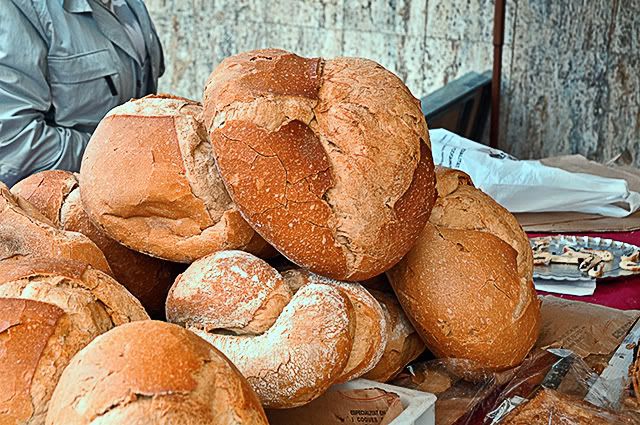
June 15, 2008
Wooden Donkey at Torrelles de Llobregat Market near Barcelona
June 14, 2008
Pickled Green Tomatoes in Barcelona
These pickled green tomatoes caught my attention at a street market. The bowl I found among other kinds of pickle products like olives or onions. It is not very common here to see green tomatoes prepared that way, at least not for us in Barcelona city. I was standing there preadjusting my camera settings and I had the opportunity to listen to some customers talking to the man in the stall. "Are these olives?" - they asked with surprise. "No, those are green tomatoes from Valencia" - said the stall man. It's a rather ridiculous story but I found the comparison between olives and green tomatoes rather ackward. Here is a green tomato pickle recipe.
June 13, 2008
Lantana Closeup in Barcelona
This is a lantana I came across in some Barcelona garden. It has been a very rainy season in the city in spite of the water crisis of past months so flowers look healthier than ever and make good photographs. Check an older picture of Lantanas. Have a nice weekend everyone!
June 12, 2008
Espadrilles: Spanish Alpargatas or Catalan Espardenyes
es·pa·drille (sp-drl) n. A shoe usually having a fabric upper part and a sole made of a flexible material, such as rope or rubber. The term espadrille is French and derives from espardenya, which derives from espart, the Catalan name for esparto [from Latin spartum] , a tough, wiry Mediterranean grass used in making rope. Espadrilles have been made in Catalonia since the 14th century at least. Here is a good place to buy yourself some comfortable espardenyes.
June 11, 2008
Street Market: Colorful Ribbons or Bracelets With Girl Names
Something I like about street markets in Barcelona and the rest of the country is that many times when you don't like what you see you can always go and refresh your eyes with the explosion of colors of South American stands. I mean, there is always a Bolivian or Peruvian stall where you don't know exactly what's on sale but you can't help staring with curiosity. Something is telling you that you want to buy. Not because of the pottery, the Che Guevara or Bob Marley T-shirts and the familiar leaf silhouette, not because of these personalized ribbons or bracelets with girl names but because of the whole impression, the warm colors, the Latin flashy hues that make the stand look more appealing than the rest. For me, much better than a 50 percent off sign.
June 10, 2008
Rusty Door Knocker in Torrelles de Llobregat , Barcelona, Spain
This beautiful rusty door knocker I captured at Torrelles de Llobregat near Barcelona although it could have been in Barcelona city perfectly as here we have many. The knocker represents some kind of mythological being perhaps. What do you make of it? I think I kind of like old door knockers and maybe I collect them in the future, the images of course. I remember a couple of posts in Barcelona Photoblog that you should check too: Vandalized Door Knocker or Modern Art? and Knocker on Chocolate Color Door at El Raval Quarter, Barcelona. Or maybe you prefer a list of famous door knockers.
June 09, 2008
Bobbin Lace or Encaje de Bolillos, Torrelles de Llobregat, Barcelona, Spain

This is a picture I took in Torrelles de Llobregat. You can see here in detail how bobbin lace, known in Spanish as encaje de bolillos, is made.
First you need a pattern or parchment where holes are pricked to mark the place for all the pins. The parchment is always laid on a pillow or cushion. The lace is worked with each hand holding at least a pair of bobbins, the wooden elongated spools or shuttles hanging from the threads, which are moved from side to side to form a twist, a braid, or a clothlike fabric called toile. The motifs are worked in a more dense stitch, and the ground is made with a looser stitch.
Bobbin lace originated in Flanders in the early 16th century although some say it came from Italy. From Flanders it extended to the rest of Europe. It was used for ruffs and collars back then.
In Spain it was customary to teach girls how to work bobbin lace at school and at home as it was considered an essential part of a woman's education.
Check this video about bobbin lace. It is short and not too illustrative but it has a brief explanation in English that might help.
June 08, 2008
Maracatu Percussion Band, Festa de la Cirera, Torrella de Llobregat, Barcelona
June 07, 2008
Cherry Festival (Festa de la Cirera), Torrelles de Llobregat, Barcelona
![Cherry Festival (Festa de la Cirera), Torrelles de Llobregat, Barcelona [enlarge]](https://i63.photobucket.com/albums/h135/carloslorenzo/CherryFestival-TorrellesdeLlobregat.jpg)
With these cherries I would like to introduce you to the Festa de la Cirera (cherry festival and market) celebrated in Torrella de Llobregat this weekend. This small town from Xth c. is only some kilometers away from Barcelona city. In fact Torrelles is a municipality in the Baix Llobregat comarque on the right bank of Llobregat river (one of the two rivers surrounding Barcelona). I have some more pictures which I'll show you in coming posts. Check Torrelles de Llobregat on Google maps.
The annual cherry festival at Torrelles de Llobregat holds deep historical significance in the Catalan region. Dating back centuries, the tradition was born out of the area's fertile soil and ideal climate for cultivating cherries. Catalan cherry orchards have long been renowned for their exceptional quality and distinctive taste.
Over time, the festival has evolved into a cherished cultural event, serving as a platform to honor the centuries-old cherry-growing heritage. It has become a symbol of community pride, where locals come together to celebrate their agricultural traditions and pay homage to the land that sustains them.
The festival's roots can be traced to the age-old practice of organizing fairs to showcase the region's bountiful harvest. Torrelles de Llobregat, with its picturesque countryside dotted with cherry trees, became the perfect setting to host this annual gathering.
Through the centuries, the festival has witnessed the evolution of cherry cultivation techniques, the introduction of new varieties, and the advancement of cherry-related industries. Today, it stands as a testament to the resilience and passion of Catalan cherry growers who have preserved this cultural heritage through generations.
The annual cherry festival not only offers a delightful gastronomic experience but also serves as a living history book, reminding us of the traditions, skills, and dedication that have shaped Catalonia's renowned cherry industry.
June 06, 2008
Gerbera Daisy Close-up
This is what was left of a gerbera daisy or at least that's how I figure it is called. Some time ago I posted a similar picture and I was kindly given the right name. I think it was Heather who did it. Thanks again. If I am in a mistake today blame me! Of course my posts are not about taxonomy but beauty, my concept of beauty. Sometimes I am lucky to match yours and more than often I fail. That's the wonderful thing. The world would be very boring otherwise.
June 05, 2008
Barcelona Trees: Horse Chestnut or Conker Flowers
Aesculus hippocastanum or common horse chestnut can be seen in some parks of Barcelona so I thought you might like the image of its flowers. These I shot in Bellaterra in early spring. I suppose it must have yielded the characteristic spiny conkers by now. From the seeds of this tree a substance called saponin aescin is extracted and used for health purposes like treating varicose veins, edema, sprains. This constituent strengthens the blood vessels and prevents thrombosis. It has haemolytic properties and is recommended as an astringent and circulatory tonic. The extracts from horse chestnut are used to treat cellulitis. So you see, the beautiful tree and its flowers are not just an adornment. Talking about adornment. Did you know that the leaves of horse chestnut trees are a common pattern in art nouveau architecture? Well, follow this fantastic link and you'll find out more about the use of nature in the Art Nouveau decoration.
June 04, 2008
Centric Point Hostel: Passeig de Gracia 33, Barcelona, Spain

Not too long ago, I uploaded three pictures about hotels in Barcelona. I suggested they could be right although it was not an affirmation. After some thought I reckon that talking only about hotels wouldn't be fair with the hostel business or better yet with young people who want to enjoy Barcelona on a low budget.
I have to confess here that whenever I think of hostels many dark, shabby places come to my mind. Every city has scary hotels, motels or hostels. But you know cliches are not to be taken too seriously. The other day, I noticed a group of young boys and girls were having a chat on the corner of Passeig de Gracia and Consell de Cent. They had come out of a building with a big sign on the door that read: Centric Point Hostel. In fact this is nothing that calls your attention for more than two seconds. They were all blond, dressing casual and showing off that unmistakable white skin that's bound to be sunburnt the following day or is already as red as a boiling lobster's shell. They didn't look like the average backpacker though, and they seemed to be pretty happy talking there. All of that made me muse a little: "Hey, this hostel in the middle of Passeig de Gracia looks like a hotel!". On one of the balconies with some towels drying up in the sun (something unthinkable in this part of the city) I saw a girl leaning and looking towards the modernist buildings nearby and I realized how privileged she was of having such great view of the most frequented and elegant street of Barcelona. The cherry on top was that the building is modernist too and has been recently restored. I am sure there are lousy places to stay in Barcelona but this one is definitely not, you would say it's a like 3 star hotel!. So I decided to share a hostel post with you today starting with a good one, of course you definitely have to check other sources too.
Here is a list of places near Centric Point Hostel:
Las Ramblas (5 minutes walking), Catalunya square (3 minutes walking)and many art nouveau (Catalan modernisme) houses such as Gaudi's Casa Batlló (50 metres), Casa Amatller (45 metres), Gaudi's Casa Milá also known as La Pedrera (5 minutes walking) or Casa Lleo Morera (5 metres). I forgot to say that along Passeig de Gracia you have the best shops in town no wonder it is one of the most expensive streets in Barcelona and Spain but you don't need to worry about that too much as it is always easy to find cheaper places to shop around in the area. I also go downtown everyday and never buy an Armani you know.
Maybe you want me to recommend some other hostels so you can compare: Hostels and a map of hostels. Have a nice, cheap and comfortable stay in Barcelona!
June 03, 2008
National Theater of Catalonia
June 02, 2008
A Day at the Races
If you've visited a local fair maybe you are familiar with the usual horse race to fight for a wonderful teddy bear. We went to Port Aventura and I prayed for my daughter not to win the first price. She had never played before so the odds were little. Bulls***, she won an enormous banana, taller than me and we had to hold it all along the park so imagine how funny it should be.
June 01, 2008
Inside the Bubble, Bubblebou Show by Pep Bou

Another picture of the Bubblebou show created by Pep Bou.
This time the artist was inside the bubble blowing out to make the surface transform adopting funny shapes. The place, Port Aventura, the amusement park on the coast of Tarragona, one of the Catalan provinces near Barcelona.
May 31, 2008
Maori Warrior at Port Aventura Amusement Park, Salou, Spain
You know what maybe the tourist in last post was lucky after all. Maybe if you didn't dance dressed like that for the crowd you would receive severe punishment for such great dishonor and you would have to face this. The scary look and the menacing gestures of a maori warrior. Man, imagine landing on the beautiful island a long time ago and being approached by a group of such warriors performing the famous dance. Wow, now I know how it must feel before the rugby match.
May 30, 2008
Maori Girls Dancing With Guest in Port Aventura
This young man saved us all from being randomly chosen by these beautiful maori girls at Port Aventura Amusement Park in Salou, Spain. I mean, who hasn't dreamed of being on a desert island, surrounded by maori girls and all...but that doesn't mean you have to dress like a scarecrow for the joy of the crowd. Tourists!!!
May 29, 2008
Masks, The Mystery of Carnivals

This one has a halo of mystery and fantasy. I chose to leave it pretty dark to concentrate just on the masks. It is not carnival anymore but I forgot to post it when I had to. Never is too late for beauty though. Looking for more? Check more pictures of the Catalan Carnival in Barcelona:
May 28, 2008
Narrow Alley
May 27, 2008
May 26, 2008
Sausage Closeup
May 25, 2008
Small Lake in the Afternoon, Ivars, Lleida
May 24, 2008
Agbar Tower Distant View
May 23, 2008
May 22, 2008
May 21, 2008
May 20, 2008
May 19, 2008
Almond Flowers

Nature has gifted us with an abundance of breathtaking sights, and one such marvel is the delicate and enchanting almond flower. Almond trees, scientifically known as Prunus dulcis, belong to the Rosaceae family and are native to the Middle East and Mediterranean regions. These stunning blossoms announce the arrival of spring, transforming vast landscapes into beautiful tapestries of white and pink hues.
The almond tree's blossoming season is a magical time, typically occurring in late winter or early spring, before the emergence of leaves. As the winter chill gives way to the gentle warmth of the sun, the almond trees awaken from their dormant state. The flowers burst forth, adorning the branches with clusters of soft, fragrant petals. It is a sight that evokes a sense of joy and anticipation, symbolizing the rejuvenation and renewal of nature.
Almond flowers are small, measuring only about an inch in diameter, and possess a five-petal structure. These petals can vary in color, ranging from pure white to shades of pale pink. Each blossom showcases a vivid center, composed of a multitude of stamens and a single pistil. The stamens bear the pollen-producing anthers, while the pistil holds the ovary, which eventually develops into the almond fruit.
The scientific name of the almond flower is Prunus dulcis var. dulcis, and it is closely related to other members of the Prunus genus, including cherries, peaches, and plums. This shared lineage is evident in the similarities in their flower structure and the overall appearance of the trees.
Almond trees have a rich history and are deeply intertwined with the culture and heritage of many regions. One such place where almond trees hold a special significance is Catalonia. The gentle Mediterranean climate and fertile soils of Catalonia provide an ideal environment for almond cultivation, making it one of the prominent almond-producing regions in Europe.
The almond blossoms are not only visually stunning but also play a crucial role in the pollination process. Bees and other pollinators are drawn to their nectar and pollen, ensuring the cross-pollination necessary for the production of almonds.
The blossoming period of almond trees in Catalonia typically occurs between January and February, marking the arrival of spring. It is a time of celebration, and local communities often organize festivals and events to honor the beauty and significance of the almond flowers. Visitors can immerse themselves in the exciting atmosphere, enjoying traditional music, dances, and local delicacies made with almonds. For example, in many towns of Lleida numerous activities are organized around almond trees in bloom. Check this interesting blog with pictures at Les Garrigues, Lleida.
The next time you witness the gentle embrace of almond blossoms, take a moment to appreciate the intricate beauty and botanical marvels they represent.
May 18, 2008
May 17, 2008
May 16, 2008
Cirque du Soleil - Alegria

Alegria: A Mesmerizing Journey into the Enchanting World of Cirque du Soleil
Cirque du Soleil, renowned for its breathtaking acrobatics, stunning visuals, and awe-inspiring performances, has captivated audiences worldwide for decades. Among its many captivating shows, Alegria stands out as a timeless masterpiece that combines artistic prowess, theatrical storytelling, and unparalleled acrobatic feats.
In this article, we will delve into the magical world of Alegria and explore the mesmerizing experience that has enchanted audiences for years.
Unveiling Alegria:
Alegria, which means "joy" in Spanish, is a Cirque du Soleil production that made its debut in 1994. Created by director Franco Dragone, the show has been performed across the globe, captivating millions with its unique blend of circus arts, theater, and music. Alegria tells a captivating story that explores the human condition, the struggle between power and weakness, and the eternal quest for happiness.
Storyline and Themes:
Set in a whimsical, dreamlike universe, Alegria takes the audience on a journey through a fantastical realm inhabited by a cast of extraordinary characters. The show's narrative revolves around the character of the Innocent, who embarks on a quest for self-discovery and seeks to reclaim the essence of joy that has been lost in a world dominated by power and corruption. Throughout the performance, Alegria explores timeless themes such as love, power, transformation, and the triumph of the human spirit.
Acrobatics and Artistry:
At the heart of Alegria lies Cirque du Soleil's signature acrobatic prowess. The show features a remarkable ensemble of world-class performers, each exhibiting exceptional strength, agility, and precision. From breathtaking aerial acrobatics to gravity-defying contortionists, the artists push the boundaries of human capability, leaving audiences in a state of sheer wonder and amazement. Alegria's choreography seamlessly blends acrobatics with dance, creating a visually stunning display of artistry that leaves a lasting impression.
Spectacular Visuals and Soundscapes:
In true Cirque du Soleil fashion, Alegria boasts a mesmerizing visual spectacle. Elaborate costumes, vivid sets, and imaginative props transport the audience into a vibrant and surreal world. The show's design reflects a fusion of historical influences, contemporary aesthetics, and whimsical flair, immersing spectators in an otherworldly experience. Complementing the visual feast is a rich musical score composed by René Dupéré, featuring a mix of haunting melodies and high-energy rhythms that perfectly enhance the emotional depth of the performance.
Legacy and Impact:
Alegria's impact on the world of entertainment cannot be overstated. The show has been seen by millions of people across the globe, earning critical acclaim and numerous awards. Its success paved the way for Cirque du Soleil's continued evolution and expansion, firmly establishing the company as a trailblazer in the realm of circus arts and live performances. Alegria's timeless themes and artistic brilliance have resonated with audiences of all ages and backgrounds, leaving a lasting impression and a sense of joy that transcends cultural boundaries.
Alegria stands as a testament to the innovative and transformative power of Cirque du Soleil. Through its captivating story, awe-inspiring acrobatics, and spellbinding visuals, the show takes audiences on an enchanting journey that leaves them inspired, moved, and filled with a renewed sense of wonder. Alegria's enduring legacy serves as a reminder of the profound impact that art and creativity can have on our lives, inviting us to embrace the joy and magic that can be found in the extraordinary.
May 15, 2008
May 14, 2008
May 13, 2008
May 12, 2008
May 11, 2008
Sardana Dancers

May 10, 2008
Sardanas at Barcelona Cathedral
May 09, 2008
May 08, 2008
May 07, 2008
May 06, 2008
May 05, 2008
May 04, 2008
May 03, 2008
May 02, 2008
May 01, 2008
Tango Dancers II, Ramblas, Barcelona, Spain
I am not too talkative today and besides an image sometimes speaks for itself. You all know what tango is. I only have to say that you can watch dancers like this couple at Las Ramblas in Barcelona. By the way this is the second time they appear in my blog, see the previous snap which is very similar although less contrasty: Tango Dancers in Las Ramblas I
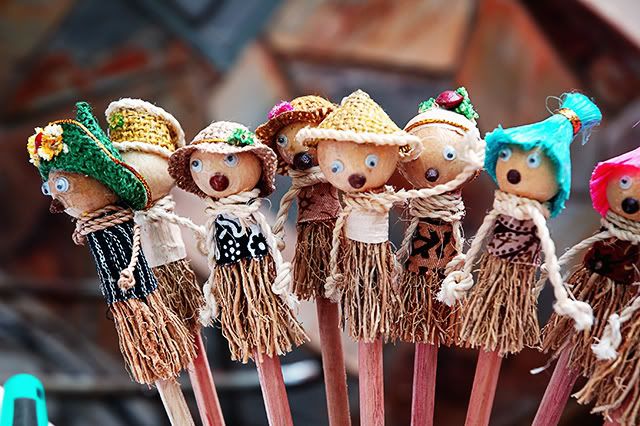

![Narrow Alley [enlarge]](https://i63.photobucket.com/albums/h135/carloslorenzo/NarrowAlley_.jpg)
